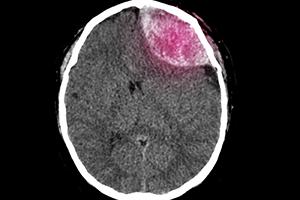The Nursing Home Law Center is committed to providing the legal resources necessary to hold negligent facilities accountable.
Nursing Home Subdural Hematoma Lawyer
Expert Legal Counsel for Brain Bleeds in Nursing Facilities
Even minor head injuries can result in significant complications for elderly nursing home residents, including death. This serious medical condition may be the result of nursing facility neglect or elder abuse, making it critical that loved ones contact an experienced nursing home abuse lawyer should their loved one suffer from a subdural hematoma injury.
Nursing Home Head Injury & Brain Bleed Settlements
Nursing home falls resulting in serious injuries like head trauma and brain bleeds are, unfortunately, a troubling issue in many healthcare settings, including nursing facilities. These incidents often stem from preventable negligence. Below are examples of settlements we’ve achieved related to these types of cases.
- $4,000,000: A wrongful death lawsuit was filed after a man fell during a hospital stay for hip replacement surgery. The nursing home fall caused a subdural hematoma, ultimately leading to his wrongful death.
- $1,700,000: Involved a patient who suffered both a hip fracture and a subdural hematoma after falling. The nursing home fall was attributed to inadequate safety measures by the staff.
- $750,000: A wheelchair-bound man, aged 76, fell down a nursing facility’s front stairs after staff failed to engage the wheelchair’s locks. The fall resulted in facial fractures and a subdural hematoma.
These settlements highlight the severe consequences of neglect in both nursing homes and other medical facilities.
Understanding How Subdural Hematomas Occur in Nursing Facilities
Commonly referred to as a brain bleed, a nursing home subdural hematoma happens when blood pools between the brain and the skull. This is one of the most severe forms of brain injuries and a leading cause of wrongful death in the elderly.
Even minor head trauma can cause hematoma and brain bleed injuries in elderly patients.
Those who have numerous risk factors, like taking blood thinners or having medical conditions that affect the brain, such as Alzheimer’s disease, have a greater risk of death from brain bleeds. Alcohol abuse is also a risk factor for suffering a subdural hematoma after an injury to the head, as it weakens blood vessels.
Nursing home falls are a common cause of subdural hematomas in the elderly. However, a blunt force impact, such as being hit in the head by nursing facility caregivers or other residents, can also lead to a subdural hematoma brain injury and subsequent wrongful death.

What is a Subdural Hematoma?
A subdural hematoma, referred to as a brain bleed, occurs when blood pools between the brain and the skull. This condition is caused by a tear in the veins of the brain’s protective covering, leading to blood leakage. There are several types of subdural hematoma, each with distinct forms and causes.
Acute Subdural Hematoma
An acute subdural injury typically results from a major injury, such as a severe fall. These cases are often seen in older adults who may have weaker blood vessels or a higher risk of serious injury.
Symptoms of an acute subdural hematoma can include loss of consciousness, headaches, slurred speech, vomiting, or neurological changes. Treatment for acute subdural hematomas often involves a craniotomy to remove the clot and relieve pressure in the brain.
Subacute Subdural Hematoma
A subacute subdural hematoma develops more gradually, with symptoms appearing several days to a few weeks after an injury. People may experience mild headaches, confusion, or balance issues. Subacute subdural hematoma cases often have underlying factors, such as clotting disorders or chronic alcohol use, that contribute to slower bleeding.
Chronic Subdural Hematoma
Chronic subdural hematomas are common in older adults. These brain bleed cases may develop with minimal or no noticeable trauma. Symptoms can include headaches, drowsiness, memory problems, or even seizures.
Diffuse Axonal Injury
Diffuse axonal injury can occur from significant impacts, like hard fall. Unlike nursing home subdural hematomas, it involves widespread damage to the brain’s connecting axons due to shearing forces during trauma. This condition often leads to severe outcomes, including coma or cognitive impairments.
Any resident who demonstrates symptoms of brain swelling or a brain bleed should be immediately seen by a medical professional.
Early Symptoms of Subdural Hematomas
Common early symptoms of brain swelling and subdural hematomas include:
- Headache
- Confusion
- Drowsiness
- Slurred speech
- Vomiting
- Vision problems
Any of these symptoms of a brain bleed in a nursing facility resident should be immediately investigated to rule out a subdural hematoma.
Worsening Symptoms
As a nursing home subdural hematoma worsens, a patient may experience the following issues:
- Personality changes, such as irritability and aggression
- Balance problems
- Paralysis on one side of the body
- Seizures
- Problems walking
- Loss of consciousness
If you note any of these symptoms of a brain bleed in your loved one, immediately get them to an emergency room for further evaluation.

Why You Need a Lawyer for Nursing Home Subdural Hematoma Cases
Nursing home subdural hematomas can be a symptom of physical abuse and neglect. For example, brain bleeds are common nursing home fall-related injuries, which points to inadequate supervision on the part of care staff.
Subdural hematoma lawyers can carefully investigate nursing home injuries, including looking at medical reports and collecting evidence from the nursing facility. A law firm can also gather expert testimony from doctors and other professionals, such as differentiating between acute subdural hematomas and chronic subdural hematomas.
A legal team has the experience to negotiate with the nursing facility’s insurance company for a reasonable settlement based on the facts of the case. The Nursing Home Law Center can take the responsible parties to court and seek redress through a civil lawsuit if necessary.
A Subdural Hematoma Lawyer Can Help Nursing Home Victims Assert Their Rights
Residents are entitled to basic rights and protections under both state and federal laws. The Nursing Home Reform Act establishes clear standards to ensure residents receive quality care and can live with dignity.
These rights include freedom from abuse and neglect, the right to proper medical care, and the right to be treated with respect. When injuries like nursing home subdural hematoma brain bleeds happen, they may indicate that these rights have been violated.
How to Prove the Nursing Home’s Liability
To prove that a nursing facility is liable for a subdural hematoma, the four facets of negligence must be proven: duty of care, breach of duty, causation, and damages. These elements are as follows.
- Duty of Care: The nursing facility was responsible for protecting the resident from serious injury.
- Breach of Duty: Because of lack of supervision, abuse, or neglect, the nursing facility failed to prevent injury.
- Causation: The subdural hematoma would not have occurred had the nursing facility and its staff members fulfilled their duty of care.
- Damages: The victim and their family suffered financial losses due to the negligence.
Proving negligence after a subdural hematoma occurs involves gathering evidence, which a lawyer can help you do.
Compensation Elderly Nursing Home Residents and Their Families Can Retrieve
Compensation for a nursing home subdural hematoma can include both economic and non-economic damages.
Economic damages are to compensate the victim and their family for financial burdens imposed by the brain injury, which can include:
- Medical bills, including emergency room visits and rehabilitation
- Lost wages for family members
- Out-of-pocket expenses for prescriptions or mobility aids
- Transportation to a new nursing home
- Funeral expenses for wrongful death
Non-economic damages consider the emotional and social impact of a subdural hematoma brain bleed on the victim and their family. This can include:
- Pain and suffering
- Emotional distress
- Loss of enjoyment of life
- Grief
- Loss of companionship
In cases of severe abuse or neglect, a subdural hematoma injury lawsuit may yield punitive damages, which are meant to punish the perpetrator. Working with an experienced legal team like the Nursing Home Law Center is essential to determine if you can sue for punitive damages.
There is no set compensation for a subdural hematoma case, as it depends on numerous factors. The severity of the subdural hematoma injury, its exact cause, the financial costs incurred, and the long-term impact of the brain injury on the family system will all play a role in determining compensation.
You Have Limited Time to File a Claim
The statute of limitations is the length of time you have to file a claim in a personal injury suit. This differs by jurisdiction but is typically between one and five years. It’s important to contact experienced subdural hematoma lawyers as soon as possible after an accident to ensure you have time to file a claim before the statute of limitations closes.
Eligibility to File a Claim
Generally, only the victim or their court-appointed representative can file a suit. For example, an individual with power of attorney over an incapacitated resident may be able to file on their behalf. We will determine who can file when you contact our law firm for a free consultation.

Important Steps to Take if You Suspect Negligence
If you suspect neglect in a nursing facility leading to a brain bleed, you must act quickly to prevent further harm to the victim.
Report and Document the Injury
Call the police or the long-term care ombudsman in your area. Take pictures of the subdural hematoma injury and gather evidence, such as the time it occurred, who was present, and the contact details of any witnesses. Take the victim to the hospital and keep copies of all medical reports.
If available, you should gather communication between the victim and nursing facility staff.
You can also contact the following services for help reporting nursing home abuse:
- National Center on Elder Abuse (NCEA): The NCEA offers information on how to identify and report elder abuse and includes a directory of resources by state.
- Nursing Adult Protective Services (NAPS): NAPS protects older adults and vulnerable individuals by investigating reports of abuse, exploitation, or neglect and connecting victims to helpful community services.
- Centers for Medicare & Medicaid Services (CMS): CMS provides information about nursing facility quality and avenues for filing complaints directly related to facilities under their oversight.
Contact a Subdural Hematoma Wrongful Death or Injury Lawyer
Contact a subdural hematoma lawyer as soon as possible for a free initial consultation and discuss your options. We can guide you through reporting potential abuse and communicate with third parties on your behalf.
Expert Legal Representation for Nursing Home Injuries
Nursing home abuse can lead to drastic consequences for victims, including head trauma and brain injuries like brain bleeds. Our team of experienced nursing home abuse and neglect lawyers can ensure that those responsible for subdural hematomas are held accountable. Use our online form or call (888)-926-7565 to book a free consultation.
Common Nursing Home Injuries

